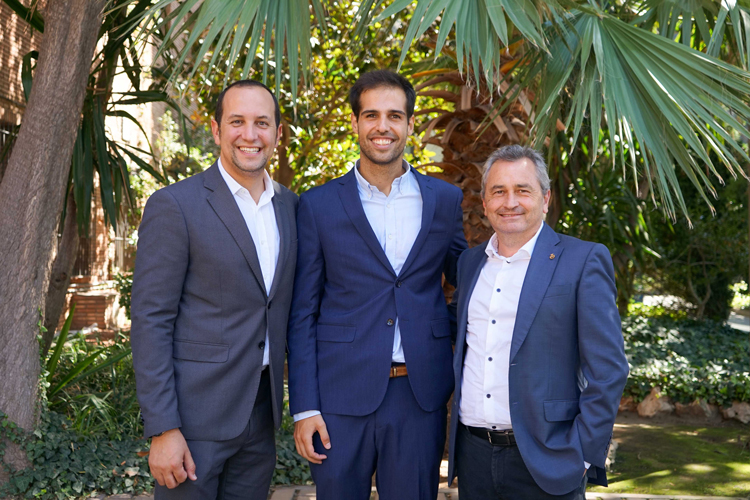Dr Alejandro Aranda recently defended his doctoral thesis at IQS, in which he designed and manufactured a new system for implanting a patch inside a human aorta that includes a guide catheter, a transport catheter, and the deployment of the patch.

Aortic dissection (AD) is one of the most catastrophic events that can occur in this artery, in which the inner layer of the aorta tears and allows blood to flow through. Although it can have fatal consequences, especially if it progresses acutely or if it ruptures the outer wall of the aorta, it is one of the cardiovascular diseases to which the least amount of study has been aimed. Current solutions are not intended for dissection treatments, but for aortic aneurysms and, when conditions allow an endovascular repair, this is carried out by means of an endoprosthesis that covers the damaged section but does not fully conform, neither geometrically nor biomechanically, to the aortic wall.
Within the GEVAB group at IQS, a new treatment for AD has been devised by placing a flexible and bio-resorbable patch on the entrance of the dissection, manufactured specifically to mimic the biomechanical environment of a healthy aorta without affecting the initial conditions of blood flow and pressure. As this is a new system, it was necessary to design a specific patch delivery and application system in order to completely cover the entire perimeter of the dissection in a minimally invasive way and to maintain the initial quality of the patch.
It is within this environment that Dr Alejandro Aranda Gil recently defended his doctoral thesis, conducted in the Department of Industrial Engineering at IQS and entitled "Creation of a delivery system for the implantation of endovascular patches." His thesis was jointly supervised by Dr Jordi Martorell López, with the Vascular Engineering and Applied Biomedicine Group (GEVAB), and Dr Andrés A. García Granada, with the Industrial Products Engineering Group (GEPI).
The main objective of this thesis has been to design and manufacture a new system that is capable of implanting the patch inside a human aorta, a system that includes a guide catheter, a conveyor catheter, and the deployment of the patch, all through an exhaustive study of the state of the art of medical device manufacturing techniques.
The designed system meets a number of essential requirements including: being able to navigate through the femoral artery and reach the aorta (two arteries that have very different dimensions), achieving deflection in it and having enough space to deploy the patch; avoiding contact of the patch with blood (to ensure sealing); and implanting the patch homogeneously.
A new endovascular implantation system 
To define the shape of the deployer, Dr Aranda carried out several design iterations with multiple patterns, measurements, and configurations until he obtained the one that managed to fold the patch into a minimum diameter hole, deploy it in the available space, and implant the patch in the wall of the blood vessel, applying homogeneous pressure over the entire surface. To test and demonstrate all these functions, ex vivo and in vivo tests were carried out with porcine models. To carry out the first one, a Pressure Applied Machine (PAM) system was designed in order to test and analyse the mechanical parameters of implementation. The features of the final shape of the deployer, as well as the multiple families of possible shapes, have been patented.
With regard to the guide catheter and the carrier, Dr Aranda’s team were able to produce a system capable of endovascularly navigating inside the arteries and bringing the deployer to its destination, orienting it towards the entrance of the dissection, and keeping it in the correct position until the definitive implantation of the patch. In this case, several iterations of the constructions of both catheters were carried out until a balance was achieved between the minimum volume necessary to fold the patch and the space available to deploy it.
To verify the correct implantation of the patch using this new device, Dr Aranda used a prototype of the aorta obtained by additive manufacturing. In addition, he used a cadaveric model and an ex vivo model, developed specifically for this purpose, the first in collaboration with the Faculty of Medicine at the UB, and the second in collaboration with LifeTec Group from Eindhoven.
With his thesis, Dr Alex Aranda has shown, once again, how multidisciplinary research is fundamental to carry out the development of technologies and devices as innovative as this new endovascular implantation system that boasts the potential to save the lives of patients with aortic diseases.
Related publications
Noemí Balà, Jordi Martorell, Salvador Borrós, Alejandro Aranda, Pau Teixidó, Carlota Molhoek, Vicente Riambau, Development of a Bioresorbable Patch to treat Aortic Dissection, Journal of Vascular Surgery, 77, issue 4, supplement (2023) https://doi.org/10.1016/j.jvs.2023.01.076
Noemí Balà et al , In Vivo Efficacy of an Adhesive Bioresorbable Patch to Treat Aortic Dissections, Journal of the American College of Cardiology (JACC), 2023, in press. https://doi.org/10.1016/j.jacbts.2023.08.002
This thesis has been conducted in collaboration with the Hospital Clínic de Barcelona and the spinoff Aortyx.
The research has been funded through an FI grant for research staff from the Government of Catalonia and the European Social Fund (020FI_B 00675, 2021FI_B1 00172, and 2022FI_B2 00023), the CaixaImpulse – "la Caixa" Foundation programme (CI17-0022 and CI92-00003), and the NEOTEC – Centre for Industrial Technological Development programme (S NEO-20191077).











